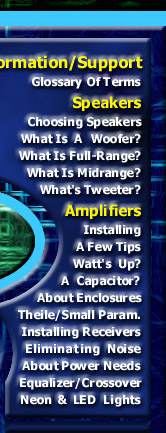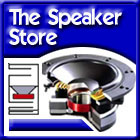




Technical
Help
& Education
Glossary Of Terms
Speakers Main Page
How Speakers Work
Choosing Speakers
What's A Woofer?
What's A Midrange?
What's A Tweeter?
Other Speaker Types
More Speaker Types
What's A Capacitor?
Installing A Capacitor
What's A Crossover?
What's An Equalizer?
Speaker Enclosures
Theile/Small Param.
About Power Amps
Installing An Amp
Installation Tips
Power Ratings
Installing/Replacing
Head Units/Receivers
Installing Neon/LED
Eliminating Noise
Use The Right Tools
Manufacturer's
Links
Personal
& Marine
Electronics
Laptop Computers
Cell Phones & PDAs
Portable TV & Video
Electronic Readers
MP3/Music Players
CD
Players/Booms
Earphones/Buds
Digital Cameras
Video
Cameras
Personal GPS
Bluetooth
Calculators
Accessories
Marine
Electronics
Stereo Amplifiers
Stereo Speakers
Stereo Woofers
Enclosed Speakers
TVS & Video
CD/Mp3 Receivers
GPS & Navigation
Fish Finders
Accessories
Home
Stereo &
Office Electronics
Flat
Screen & HD TVs
Surround Sound
Home Theater
DVD Players/Tivo
DVD Recorders
Blu-Ray Devices
Amplifiers/Tuners
Speaker
Systems
Subwoofer Drivers
Midrange
Drivers
Tweeter Drivers
Powered Subwoofers
Outdoor
Speakers
Stereo Accessories
Digital
Photo Frames
Video Game Systems
Game
Accessories
Video Games
Home Security/Alarms
Computer
Products
Desktops & Laptops
Add-Ons/Peripherals
Computer Monitors
Computer Software
Computer Games
Printers &
Scanners
Ink/Specialty Papers
Parts & Components
Computer Supplies
Security/Tech
Support
Auto
Electronics
Amplifiers
Subwoofers
Full-Range Speakers
Midrange Speakers
Tweeters
Power Capacitors
Empty
Enclosures
Loaded Enclosures
CD/Mp3 Receivers
CD Changers
Bass Packages
Car
TV & Video
Satellite
Radio
Bluetooth Wireless
GPS Navigation
Neon/LED Lighting
Radar Detectors
Chrome
Mufflers
Car Alarms/Security
V
AUTO
PARTS STORE
Auto
Wiring &
Accessories
Air Horns
Power
Antennas
Antenna Boosters
A/V Controllers
Bass Blockers
Crossovers
Dynamat
Equalizers
Fans (Cooling)
FM Modulators
Interfaces
Line Converters
Noise Filters
Power Inverters
Power Supplies
RCA Cables
RCA Splitters
Remote Controls
Signal Boosters
Vibration Control
Speaker Grills
Wiring Kits
Like it loud?
If
your lights dim with the beat, or your speakers start smoking without permission,
or your CD skips a beat or two, your amplifier may be trying to use more
fast energy than the electrical system can supply. Unfortunately, your car's
electrical system is not thinking about the needs of your amplifier. Power
is being robbed from your audio system by such trifling matters as: the engine
and lights. This may leave your amplifier hungry for power, and worse, delivering
destructive distortion when it fails to get it.
Understand of course, that no capacitor is a substitute for an adequate amplifier
to provide the amount of bass energy you want to project. Nor will it substitute
for an inadequate car power supply. You may have to install a stronger alternator
if you have one of the more powerful systems. The rest of your system must
also be "up to spec" to serve that purpose.
Technically
, a capacitor is
an electronic device which consists of two rolled up plates of electrically
conductive material separated by an insulator known as a dielectric. Within
this frame an electrical field charge is developed. The quantum of this charge
is the capacitor's value, measured in farads. It is largely determined by
the surface area of the plates, the effective distance between the plates,
and the chemical composition of the dielectric material.
Audio
capacitors
are energy
reservoirs that store the necessary power your amplifier will need to punch
those big bass notes while limiting
clipping
(see
definition at right).
They store power during intervals when
it is not required, which is most of the time, and release it when a short
term transient demand exceeds what is available from the car's power system.
A stiffening capacitor for your amp is the simplest way to be sure your system
always gets every bit of immediate current it needs.
From the smallest .5 farad, to 10 farads, there's a capacitor suitable for
your installation. Mount them as close to the amplifier as possible, and
use at least .5 farad (500,000 microfarads) per 500 watts RMS of power output.
Using more will not cause problems. On the other hand, it will not contribute
to the operation either, and it's easier on the wallet to just get what you
need.
Many capacitors are rated for ESR. This is the Equivalent Series Resistance of a capacitor. A perfect capacitor would have only capacitance. All conductors have resistance. In a capacitor, there are many conductors such as terminal leads, foil and even the dielectric electrolyte. The resistance of all of these conductors contribute to the capacitor's series resistance. It's essentially the same as having a resistor in series with an ideal capacitor. Capacitors with relatively high ESR will have less ability to pass current from its plates to the load (the amplifier).
Discharging the Capacitor:
If you plan to remove your capacitor for any reason, you may want to completely
discharge the capacitor to avoid a potential hazard. To discharge the capacitor
(only after it's disconnected from the system, of course), will need to enable
the current to flow from one terminal to the other. You can use either a
test light or resistor for this purpose. Some large capacitors tend to develop
a charge similar to a battery and will produce a small voltage across its
terminals. Since, in a large capacitor (over .5 farad), even a small voltage
could be dangerous. After it is discharged, you may want to connect the terminals
together with a piece of wire or resistor. Even if the capacitor design doesn't
permit it to develop adverse voltages when unused, leave the terminals connected
as a visual confirmation of the unit's safety.
Charging with a Resistor:
Many capacitors will need to be intialized with a 10 to 50 ohm resistor connected
to the power main for usually 8 to 25 seconds depending on the size. After
charging is completed, simply connect the power main VERY Carefully.
All the capacitors we sell, come with exact instructions for connection;
follow them exactly.
For information on installing capacitors, see this page .
MAIN
PAGE
GLOSSARY
SPEAKERS:
Choosing
General
Woofers
Miidrange
Tweeters
Full-Range
Full-Range 2
CAPACITORS
CROSSOVERS
EQUALIZERS
Theile/Small
AMPLIFIERS:
About
Installing
Install Tips
Power Ratings
RECEIVERS:
Installing
NEON/LED:
Installing
TOOLS
Home
--
Policies
--
Products
--
Tech
Center
--
Auto
Electronics
--
Home
Electronics
--
Personal
& Marine Electronics
--
Stereo
Tech Info
Website Designed & Maintained by
MetroDirect
Communications
Copyright (c) 2000 - 2009
Electronixwarehouse.com
.
Use of any material appearing on this site without specific written
permission is prohibitied by law.
electronixwarehouse.com
---
logobannerfactory.com
---
bleepthem.com (Political Satire)
---
rlebeaux.com
---
stereotechnicalinformation.com (Stereo
Technical Help)
---
electronixwarehouse.net
---
thespeakerstore.com
---
wmpublishing.com (Help For Writers)
---
barbarathenovel.com
---
cutethenovel.com





